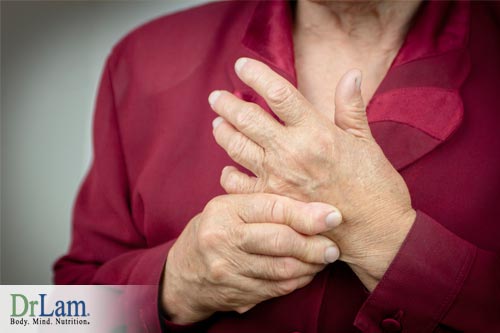 People who suffer from the effects of Adrenal Fatigue Syndrome (AFS) experience a wide variety of non-specific symptoms that lead them to a weakened state if they persist. Some of the physical symptoms can be remedied by yoga advantages. Among these symptoms is arthritis.
People who suffer from the effects of Adrenal Fatigue Syndrome (AFS) experience a wide variety of non-specific symptoms that lead them to a weakened state if they persist. Some of the physical symptoms can be remedied by yoga advantages. Among these symptoms is arthritis.
Not everyone who has arthritis suffers from AFS, but many do. All of them seek relief. Certain exercise regimens seem to help with yoga drawing significant attention.
A recent study from the Emirates Arthritis Foundation showed 12 session of Raj yoga to be effective in helping subjects with rheumatoid arthritis symptoms. This gentler form of yoga consists of breathing and exercise techniques. Participants reported improvements in scores on questionnaires about disease activity and health assessment. Quality of life wasn’t improved significantly.
Overall, people who suffer from rheumatoid arthritis tend to experience less pain and become more physically active if they exercise regularly. This study shows mild exercise yoga advantages improved the subjective pain experience.
Yoga has been used to boost health for 5,000 years. Studies have shown yoga advantages have very positive effects on pain symptoms due to arthritis.
A study at the University of Pennsylvania showed participants in an eight week program of lyengar yoga classes reported less pain from their knee osteoarthritis, improvement in physical function, and a decrease in joint stiffness.
Another study involving lyengar yoga was conducted at UCLA Medical Center. Women with rheumatoid arthritis felt an immediate, positive effect on their symptoms. Their day-to-day pain levels remained the same, but they felt the pain differently. Increased energy helped them perform daily activities more effectively.
Other yoga advantages have shown a reduction in tension and an increase in joint flexibility. Muscle strength is increased, balance improved, and yoga is an enjoyable activity. This latter makes it more likely that people with arthritis will stay with an exercise regimen.
Yoga also appears to fight inflammation that causes joint swelling, redness, and pain. Inflammation also will ultimately result in destruction of joints. A 2010 study at Ohio State University involved 50 women using Hatha yoga postures. Measures of inflammation-causing proteins like interleukin-6 showed lower levels in those women who were more experienced in yoga. Other markers were measured as well. Women who were new to yoga showed higher levels of these markers in their blood than did women more experienced in yoga.
A study from India studied 64 men and women with rheumatoid arthritis during a week-long, intensive yoga program. Participants showed reduced rheumatoid factor levels in their blood. This factor is associated with inflammation.
Yoga advantages appear to be helping people deal with arthritis. Not only does it bring benefits from exercise, but also benefits including relaxation and reducing stress. Both relaxation and stress reduction aids people in their experience of pain. Increasing relaxation and learning to cope better with stress not only aids people in dealing with arthritis pain, it also helps them deal with the results of stress overall. One ultimate result of stress may be adrenal fatigue syndrome.
 The broad collection of symptoms that marks AFS includes arthritis. Often conventional medicine disregards AFS as a cause of arthritis and treats the symptom only. Most times, this treatment is more and more powerful pain medications with their inherent side effects. Pain medications can put a strain on the liver. A sluggish liver may result. As the liver slows, toxins can build up in the body and deposit into muscles and joints, worsening joint pain and muscle aches.
The broad collection of symptoms that marks AFS includes arthritis. Often conventional medicine disregards AFS as a cause of arthritis and treats the symptom only. Most times, this treatment is more and more powerful pain medications with their inherent side effects. Pain medications can put a strain on the liver. A sluggish liver may result. As the liver slows, toxins can build up in the body and deposit into muscles and joints, worsening joint pain and muscle aches.
Adrenal fatigue comes on slowly as a result of stress that leads to the adrenal glands releasing cortisol, the body’s stress fighting hormone, to help us deal with it. If the stress continues, the adrenals are called on more and more to release cortisol. Ultimately, adrenal exhaustion can occur, resulting in cortisol levels too low to be of use in dealing with stress.
Whatever the source of stress, the body responds the same. Arthritis is one source of stress that leads to activation of the hypothalamic-pituitary-adrenal axis resulting in release of cortisol to fight the stress.
When the body is no longer able to handle stress adequately, it begins breaking down. The person under this condition may become so disabled as to become bed-ridden. Normal daily chores require help. The body is in a state of conserving everything in an effort to survive.
Muscle weakness, loss of appetite, hypoglycemia, depression, extreme fatigue, dehydration, and electrolyte imbalances appear. The body’s natural homeostatic balance is gone. But it doesn’t have to come to that. Understanding how the body responds to stress and the body systems involved leads to proper treatment of symptoms developed by this response.
Unfortunately, conventional medicine often misses the connections among body systems in stress. Currently, the understanding of the stress response involves the neuroendocrine system. That this system is in charge of a great deal of our stress response is well accepted.
The drawback to viewing the stress response in this way is its limiting treatment to organs and symptoms individually, instead of systemically. This limitation often leads to continuation of and increase in symptoms related to our body’s stress response.
A more comprehensive perspective includes the metabolic system. This neuroendometabolic (NEM) viewpoint allows physicians to understand how body systems act and react together dynamically in responding to stress.
This functional medicine approach to stress response shows how one system of the body affected by stress affects all other systems as well. Thus, when the immune system is involved in stress, the inflammatory response is triggered. This in turn affects the hormonal response in which the adrenal glands are stimulated. The adrenal glands can release cortisol, which is also an anti-inflammatory hormone. Cortisol can help reduce inflammation in joints and throughout the body. However, stress is once again placed on the adrenal glands to do so, and may worsen adrenal fatigue.
Stress affects every part of the body. Treating stress symptoms becomes more comprehensive with this approach, as well. It opens up the physician’s armamentarium of possible treatments to include diet, relaxation, decreasing inflammation, detoxifying the body, and on and on. It’s a way to gain complete relief.
 Yoga is a great way to help the body relieve stress. It is also beneficial for reducing inflammation. These are both great steps to helping the adrenals heal. However, if the body is in advanced stages of adrenal fatigue, energy conservation is typically the highest priority. In these cases, even gentle yoga can expend too much energy for the adrenals and the body to handle. As well, certain yoga positions can activate the sympathetic nervous system and fight or flight response. Adrenaline floods the body as a result, resulting in anxiety, nervousness, and panic attacks. Adrenal crashes can also be triggered in certain cases. Those who are weak and in advanced stages of AFS is particularly vulernable. The benefits may not outweigh the consequences. It is thus important that you consult your primary medical doctor before embarking on a exercise or yoga program.
Yoga is a great way to help the body relieve stress. It is also beneficial for reducing inflammation. These are both great steps to helping the adrenals heal. However, if the body is in advanced stages of adrenal fatigue, energy conservation is typically the highest priority. In these cases, even gentle yoga can expend too much energy for the adrenals and the body to handle. As well, certain yoga positions can activate the sympathetic nervous system and fight or flight response. Adrenaline floods the body as a result, resulting in anxiety, nervousness, and panic attacks. Adrenal crashes can also be triggered in certain cases. Those who are weak and in advanced stages of AFS is particularly vulernable. The benefits may not outweigh the consequences. It is thus important that you consult your primary medical doctor before embarking on a exercise or yoga program.
Adrenal Yoga Exercise is a special form of yoga that is designed to strength the core of the body, provide fluidity and control as adrenal is going through the recovery process. Sympathetic stimualtion is avoided. It should be the program of choice among AFS sufferers until their adrenal recaovery is well on its way and the body stabilizes.
